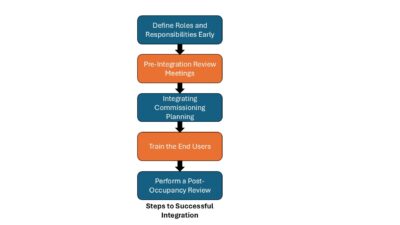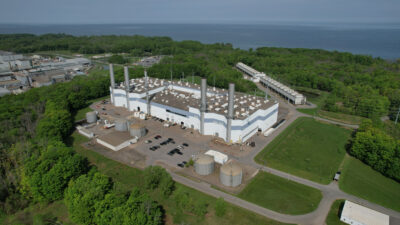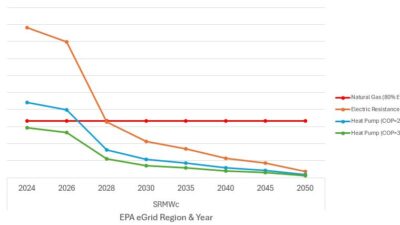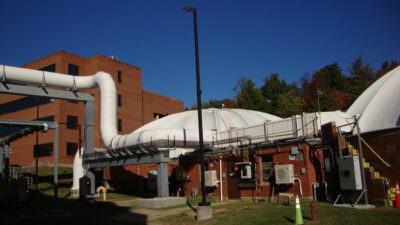Heating system choices should weigh future grid emissions, energy costs, and peak electric demand. Read about one Chicago-area laboratory.
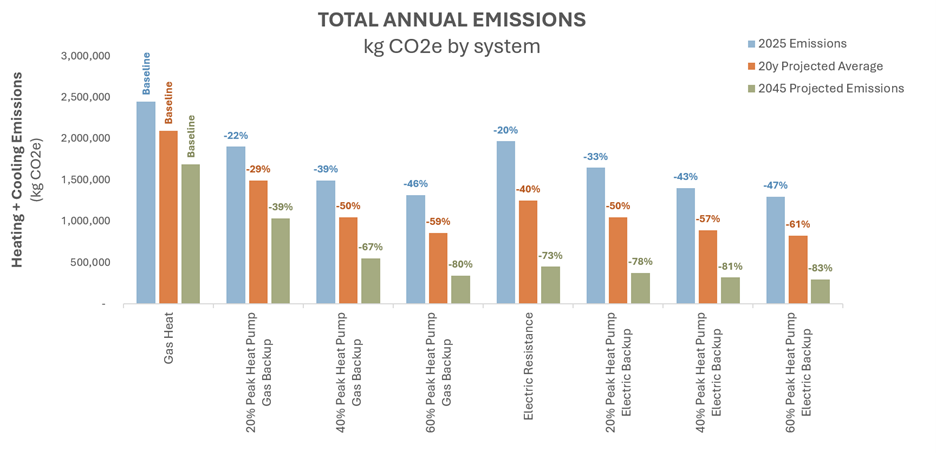
Heating plant insights:
- This article compares multiple heating plant configurations to evaluate their impact on energy cost, carbon emissions and peak electric demand.
- Heating plant choices — including combinations of gas boilers, electric boilers and heat pumps — affect long-term sustainability based on evolving grid conditions.
When evaluating the relative performance of gas boilers versus heat pumps versus electric boilers, a critical starting point is the carbon intensity of the electric grid serving the building. NREL’s Scenario Viewer is a valuable tool for assessing this, offering insight into both current and projected grid emissions.
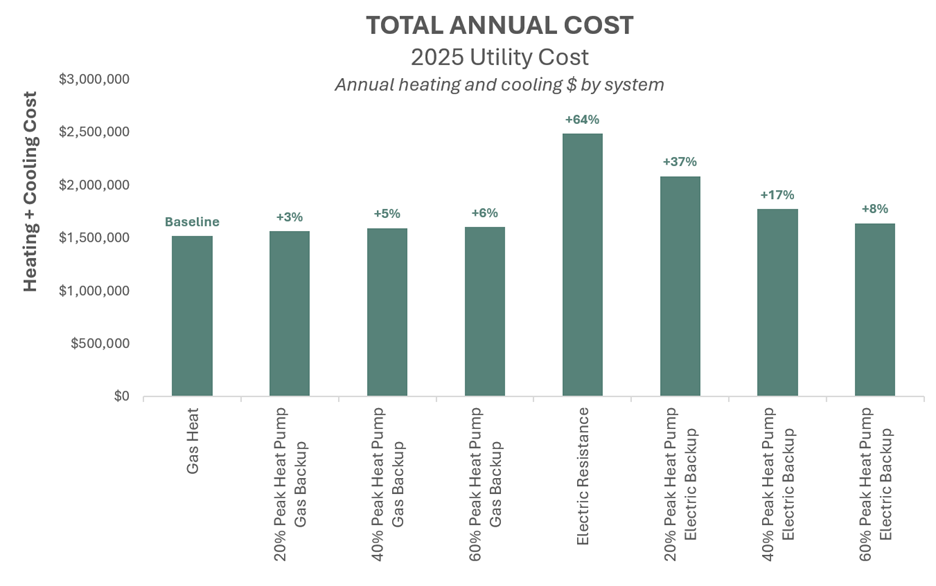
This heating plant case study examines a 200,000-square-foot laboratory facility in the Chicago area, comprising 60% laboratory space and 40% office, classroom and support areas. Utility rates are typical for the region. According to Cambium data, northern Illinois is among the cleanest grid regions in the U.S., largely due to its substantial nuclear baseload. The region’s generation mix is expected to evolve significantly over the next 25 years, with increasing contributions from renewables and declining carbon intensity.
Given this evolving grid profile, it is essential to evaluate both current and future carbon emissions when assessing heating system options. Electricity consumed in 2045 is projected to have significantly lower associated emissions than electricity used in 2025 per NREL’s Standard Scenarios dataset, which has major implications for long-term sustainability planning.

The building’s annual heating and cooling load profiles were developed and used to simulate various heating plant configurations. To simplify the comparison between gas boilers, heat pumps and electric boilers, energy recovery chillers were excluded, despite the simultaneous loads making a strong case for one.
Eight heating plant configurations were simulated to evaluate energy cost, carbon emissions and peak electric demand:
- Gas boiler only
- 20% air-source heat pumps (ASHPs) (primary source), 80% gas boiler (secondary source)
- 40% ASHP (primary source), 60% gas boiler (secondary source)
- 60% ASHP (primary source), 40% gas boiler (secondary source)
- Electric boiler only
- 20% ASHP (primary source), 80% electric boiler (secondary source)
- 40% ASHP (primary source), 60% electric boiler (secondary source)
- 60% ASHP (primary source), 40% electric boiler (secondary source)
Annual energy cost results indicate that all configurations incorporating ASHPs or electric boilers result in higher operating costs than the gas boiler-only baseline. This may seem surprising; however, this can be attributed to the exclusion of heat recovery chillers and the use of ASHPs, which are less efficient than other heat pump types. Additionally, natural gas remains relatively inexpensive in the region.
Carbon emissions were evaluated for each configuration using site emissions (from on-site combustion) and source emissions (from grid electricity). Emissions were calculated for three timeframes: 2025, 2045 and a 20-year weighted average, to demonstrate the impact the changing electric grid will have on the building’s emissions over time.
Note that any amount of heat pump was found to be helpful and reduce emissions. In the second option — 20% ASHP and 80% gas boiler — the addition of a small quantity of ASHPs reduces the emissions by 39% by 2045.
The analysis also reveals diminishing returns in carbon savings as ASHP capacity increases. For the heat pump plus gas boiler options, increasing the heat pump share from 20% of peak load to 40% makes a substantial difference. The increase from 40% to 60% is less impactful. For the heat pump plus electric boiler options, the point of diminishing returns comes much earlier.
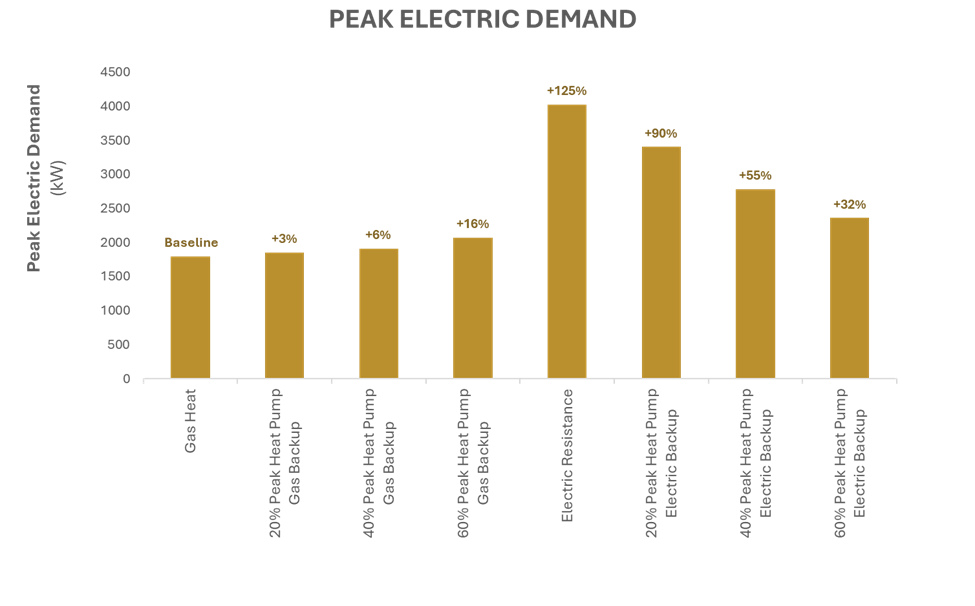
However, peak electric demand also comes into play. ASHP plus gas boiler configurations result in modest increases in peak demand, primarily during summer, which is why the increase in electricity demand does not scale with the heat pump percentage. In contrast, all-electric configurations (ASHP plus electric boiler or electric boiler only) lead to significantly higher peak demands. Because some modern ASHPs can operate at coefficients of performance around 2.0 at outdoor temperatures at or below zero, an increase in heat pump quantity can significantly reduce peak electric demand relative to electric boilers only.
This case study illustrates the importance of considering both current and future grid emissions, energy costs and peak demand when selecting heating systems. While no single configuration emerges as the clear winner across all metrics, the analysis framework presented here can guide decision-making based on an owner’s priority — whether it be cost, carbon footprint or grid impact.

